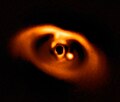 Hereford Arizona Observatory (HAO) HAO#1 and HAO#2. | |
| Organization | |
|---|---|
| Observatory code | G95 |
| Location | Arizona |
| Coordinates | 31°27′08″N110°14′16″W / 31.4522°N 110.2378°W |
| Altitude | 4,670 ft (1,420 m) |
| Website | www |
| Commercial telescopes |
|
| | |
Hereford Arizona Observatory (HAO), IAU-code G95, is an astronomical observatory, [1] [2] owned and operated by amateur astronomer Bruce L. Gary. [3] Observational studies of unusual starlight fluctuations in Tabby's Star (KIC 8462852) [4] and WD 1145+017 [5] are recent interests.
Contents
HAO consists of two telescopes, in two separate observatory installations: HAO#1 (contains a Celestron CPC 1100, 11-inch Schmidt-Cassegrain telescope on an equatorial mount) and HAO#2 (contains an Astro-Tech Ritchey–Chrétien, 16-inch telescope on an equatorial mount). [1]
The observatory is located in Arizona about 130 km (80 mi) southeast of Tucson and about 11 km (7 mi) north of the Mexican border. Coordinates are at the following: North Latitude +31:27:08 and West Longitude 110:14:16, at an altitude of 1,423 m (4,670 ft). [1]









